
List of Sultans of the Ottoman Empire
Encyclopedia
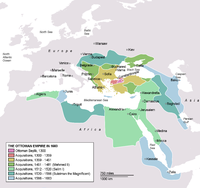
Sultan
Sultan is a title with several historical meanings. Originally, it was an Arabic language abstract noun meaning "strength", "authority", "rulership", and "dictatorship", derived from the masdar سلطة , meaning "authority" or "power". Later, it came to be used as the title of certain rulers who...
of the Ottoman Dynasty
Ottoman Dynasty
The Ottoman Dynasty ruled the Ottoman Empire from 1299 to 1922, beginning with Osman I , though the dynasty was not proclaimed until Orhan Bey declared himself sultan...
ruled over a vast transcontinental empire from 1299 to 1922. At its height, the Ottoman Empire
Ottoman Empire
The Ottoman EmpireIt was usually referred to as the "Ottoman Empire", the "Turkish Empire", the "Ottoman Caliphate" or more commonly "Turkey" by its contemporaries...
spanned from Hungary
Hungary
Hungary , officially the Republic of Hungary , is a landlocked country in Central Europe. It is situated in the Carpathian Basin and is bordered by Slovakia to the north, Ukraine and Romania to the east, Serbia and Croatia to the south, Slovenia to the southwest and Austria to the west. The...
in the north to Somalia
Somalia
Somalia , officially the Somali Republic and formerly known as the Somali Democratic Republic under Socialist rule, is a country located in the Horn of Africa. Since the outbreak of the Somali Civil War in 1991 there has been no central government control over most of the country's territory...
in the south, and from Algeria
Algeria
Algeria , officially the People's Democratic Republic of Algeria , also formally referred to as the Democratic and Popular Republic of Algeria, is a country in the Maghreb region of Northwest Africa with Algiers as its capital.In terms of land area, it is the largest country in Africa and the Arab...
in the west to Iraq
Iraq
Iraq ; officially the Republic of Iraq is a country in Western Asia spanning most of the northwestern end of the Zagros mountain range, the eastern part of the Syrian Desert and the northern part of the Arabian Desert....
in the east. Administered at first from the city of Bursa in Anatolia
Anatolia
Anatolia is a geographic and historical term denoting the westernmost protrusion of Asia, comprising the majority of the Republic of Turkey...
, the empire's capital was moved to Edirne
Edirne
Edirne is a city in Eastern Thrace, the northwestern part of Turkey, close to the borders with Greece and Bulgaria. Edirne served as the capital city of the Ottoman Empire from 1365 to 1453, before Constantinople became the empire's new capital. At present, Edirne is the capital of the Edirne...
in 1366 and then to Constantinople
Constantinople
Constantinople was the capital of the Roman, Eastern Roman, Byzantine, Latin, and Ottoman Empires. Throughout most of the Middle Ages, Constantinople was Europe's largest and wealthiest city.-Names:...
(currently known as Istanbul
Istanbul
Istanbul , historically known as Byzantium and Constantinople , is the largest city of Turkey. Istanbul metropolitan province had 13.26 million people living in it as of December, 2010, which is 18% of Turkey's population and the 3rd largest metropolitan area in Europe after London and...
) in 1453 following its capture
Fall of Constantinople
The Fall of Constantinople was the capture of the capital of the Byzantine Empire, which occurred after a siege by the Ottoman Empire, under the command of Ottoman Sultan Mehmed II, against the defending army commanded by Byzantine Emperor Constantine XI...
from the Byzantine Empire
Byzantine Empire
The Byzantine Empire was the Eastern Roman Empire during the periods of Late Antiquity and the Middle Ages, centred on the capital of Constantinople. Known simply as the Roman Empire or Romania to its inhabitants and neighbours, the Empire was the direct continuation of the Ancient Roman State...
. The Ottoman Empire's early years
Rise of the Ottoman Empire
The Foundation and Rise of the Ottoman Empire refers to the period which started with the weakening of the Seljuq Sultanate of Rûm in the very early 14th century and ended with the Byzantine Empire decline and the Fall of Constantinople on May 29, 1453.The rise of the Ottomans correlates with the...
have been the subject of varying narratives due to the difficulty of discerning fact from legend; nevertheless, most modern scholars agree that the empire came into existence around 1299 and that its first ruler was Osman I
Osman I
Osman I or Othman I or El-Gazi Sultan Osman Ghazi, or Osman Bey or I. Osman, Osman Gazi Han), nicknamed "Kara" for his courage, was the leader of the Ottoman Turks, and the founder of the dynasty that established and ruled the Ottoman Empire...
Khan
Khan (title)
Khan is an originally Altaic and subsequently Central Asian title for a sovereign or military ruler, widely used by medieval nomadic Turko-Mongol tribes living to the north of China. 'Khan' is also seen as a title in the Xianbei confederation for their chief between 283 and 289...
(leader) of the Kayı tribe of the Oghuz Turks
Oghuz Turks
The Turkomen also known as Oghuz Turks were a historical Turkic tribal confederation in Central Asia during the early medieval Turkic expansion....
. The Ottoman Dynasty he founded was to endure for six centuries through the reigns of 36 sultans. The Ottoman Empire disappeared as a result of the defeat of the Central Powers
Central Powers
The Central Powers were one of the two warring factions in World War I , composed of the German Empire, the Austro-Hungarian Empire, the Ottoman Empire, and the Kingdom of Bulgaria...
with whom it had allied itself during World War I
World War I
World War I , which was predominantly called the World War or the Great War from its occurrence until 1939, and the First World War or World War I thereafter, was a major war centred in Europe that began on 28 July 1914 and lasted until 11 November 1918...
. The partitioning of the empire
Partitioning of the Ottoman Empire
The Partitioning of the Ottoman Empire was a political event that occurred after World War I. The huge conglomeration of territories and peoples formerly ruled by the Sultan of the Ottoman Empire was divided into several new nations.The partitioning was planned from the early days of the war,...
by the victorious Allies
Allies of World War I
The Entente Powers were the countries at war with the Central Powers during World War I. The members of the Triple Entente were the United Kingdom, France, and the Russian Empire; Italy entered the war on their side in 1915...
and the ensuing Turkish War of Independence
Turkish War of Independence
The Turkish War of Independence was a war of independence waged by Turkish nationalists against the Allies, after the country was partitioned by the Allies following the Ottoman Empire's defeat in World War I...
led to the birth of the modern Republic of Turkey
Turkey
Turkey , known officially as the Republic of Turkey , is a Eurasian country located in Western Asia and in East Thrace in Southeastern Europe...
.
Ottoman State Organization
The Ottoman State was an absolute monarchyAbsolute monarchy
Absolute monarchy is a monarchical form of government in which the monarch exercises ultimate governing authority as head of state and head of government, his or her power not being limited by a constitution or by the law. An absolute monarch thus wields unrestricted political power over the...
during much of its existence. The sultan was at the apex of the hierarchical Ottoman system and acted in political, military, judicial, social, and religious capacities under a variety of titles. He was theoretically responsible only to God
God
God is the English name given to a singular being in theistic and deistic religions who is either the sole deity in monotheism, or a single deity in polytheism....
and God's law (the Islamic şeriat, known in Arabic as sharia
Sharia
Sharia law, is the moral code and religious law of Islam. Sharia is derived from two primary sources of Islamic law: the precepts set forth in the Quran, and the example set by the Islamic prophet Muhammad in the Sunnah. Fiqh jurisprudence interprets and extends the application of sharia to...
), of which he was the chief executor. His heavenly mandate
Divine Right of Kings
The divine right of kings or divine-right theory of kingship is a political and religious doctrine of royal and political legitimacy. It asserts that a monarch is subject to no earthly authority, deriving his right to rule directly from the will of God...
was reflected in Irano-Islamic titles such as "shadow of God on Earth" (zill Allah fi'l-alem) and "caliph of the face of the earth" (halife-i ru-yi zemin). All offices were filled by his authority, and every law was issued by him in the form of a decree called firman. He was the supreme military commander
Commander-in-Chief
A commander-in-chief is the commander of a nation's military forces or significant element of those forces. In the latter case, the force element may be defined as those forces within a particular region or those forces which are associated by function. As a practical term it refers to the military...
and had the official title to all land. Ertoghrul
Ertugrul
Ertuğrul was the father of Osman I, the founder of the Ottoman Empire. He was the leader of the Kayı clan of the Oghuz Turks...
served as the elected leader of the Ottomans from 1230 until his death in 1281. In 1281, Ertoghrul's son, Osman, became elected leader of the Ottomans. From 1299 until his death in 1324, Osman served as Osman I
Osman I
Osman I or Othman I or El-Gazi Sultan Osman Ghazi, or Osman Bey or I. Osman, Osman Gazi Han), nicknamed "Kara" for his courage, was the leader of the Ottoman Turks, and the founder of the dynasty that established and ruled the Ottoman Empire...
"Sultan
Sultan
Sultan is a title with several historical meanings. Originally, it was an Arabic language abstract noun meaning "strength", "authority", "rulership", and "dictatorship", derived from the masdar سلطة , meaning "authority" or "power". Later, it came to be used as the title of certain rulers who...
of the Ottoman Empire
Ottoman Empire
The Ottoman EmpireIt was usually referred to as the "Ottoman Empire", the "Turkish Empire", the "Ottoman Caliphate" or more commonly "Turkey" by its contemporaries...
."
After the fall of Constantinople
Fall of Constantinople
The Fall of Constantinople was the capture of the capital of the Byzantine Empire, which occurred after a siege by the Ottoman Empire, under the command of Ottoman Sultan Mehmed II, against the defending army commanded by Byzantine Emperor Constantine XI...
in 1453, Ottoman sultans came to regard themselves as the successors of the Roman Empire, hence their occasional use of the titles Caesar
Caesar (title)
Caesar is a title of imperial character. It derives from the cognomen of Julius Caesar, the Roman dictator...
(kaysar) and Emperor
Emperor
An emperor is a monarch, usually the sovereign ruler of an empire or another type of imperial realm. Empress, the female equivalent, may indicate an emperor's wife or a woman who rules in her own right...
. Following the conquest of Egypt in 1517, Selim I
Selim I
Selim I, Yavuz Sultân Selim Khan, Hâdim-ül Haramain-ish Sharifain , nicknamed Yavuz "the Stern" or "the Steadfast", but often rendered in English as "the Grim" , was the Sultan of the Ottoman Empire from 1512 to...
also adopted the title of caliph
Caliph
The Caliph is the head of state in a Caliphate, and the title for the ruler of the Islamic Ummah, an Islamic community ruled by the Shari'ah. It is a transcribed version of the Arabic word which means "successor" or "representative"...
, thus claiming to be the universal Muslim ruler. Newly enthroned Ottoman rulers were girded with the Sword of Osman
Sword of Osman
The Sword of Osman was an important sword of state used during the coronation ceremony of the sultans of the Ottoman Empire. The sword was named after Osman I, founder of the Ottoman Dynasty. The practice started when Osman I was girt with the sword of Islam by his mentor and father-in-law Sheik...
, an important ceremony that served as the equivalent of European monarchs' coronation. A non-girded sultan was not eligible to have his children included in the line of succession.
Although theocratic and absolute in theory and in principle, the sultan's powers were limited in practice. Political decisions had to take into account the opinions and attitudes of important members of the dynasty, the bureaucratic and military establishments, as well as religious leaders. From the 17th century onwards, the empire entered into a long-term period of stagnation
Stagnation of the Ottoman Empire
The Stagnation of the Ottoman Empire is the period following the Growth of the Ottoman Empire . During this period the empire continued to have military might. The next period would be shaped by the decline of their military power which followed the loss of huge territories...
, during which the sultans were much enfeebled. Many of them ended up being deposed by the powerful Janissary
Janissary
The Janissaries were infantry units that formed the Ottoman sultan's household troops and bodyguards...
corps. Despite being barred from inheriting the throne, women of the Imperial Harem
Imperial Harem
The Imperial Harem of the Ottoman Empire was one of the most important elements of the Ottoman court. It was known in the West as "the Seraglio", an Italian term.- Harem quarters:...
—especially the reigning sultan's mother, known as the Valide Sultan
Valide Sultan
Valide Sultan was the title held by the mother of a ruling Sultan in the Ottoman Empire. The Turkish pronunciation of the word Valide is . The title is sometimes translated as Queen Mother, although the position of Valide Sultan was quite different.The position was perhaps the most important...
—also played an important behind-the-scenes political role, effectively ruling the empire during the period known as the sultanate of women
Sultanate of Women
The Sultanate of Women was the near 130-year period during the 16th and 17th centuries when the women of the Imperial Harem of the Ottoman Empire exerted extraordinary political influence. Many of the Sultans during this time were minors and it was their mothers, leaders of the Harem, who...
.
The declining powers of the sultans are evidenced by the difference in reign lengths between early sultans and later ones. Suleiman I
Suleiman the Magnificent
Suleiman I was the tenth and longest-reigning Sultan of the Ottoman Empire, from 1520 to his death in 1566. He is known in the West as Suleiman the Magnificent and in the East, as "The Lawgiver" , for his complete reconstruction of the Ottoman legal system...
, who ruled the empire when it was at its zenith in the 16th century, had a reign of 46 years, the longest in Ottoman history. Murad V
Murad V
Murad V was the 33rd Sultan of the Ottoman Empire who reigned from 30 May to 31 August 1876.He was born at Istanbul , Topkapı Palace. His father was Abdülmecid I...
, who ruled in the late 19th-century period of decline, had the shortest reign on record: he was in power for just 93 days before being deposed. Constitutionalism
Constitutional monarchy
Constitutional monarchy is a form of government in which a monarch acts as head of state within the parameters of a constitution, whether it be a written, uncodified or blended constitution...
was only established
First Constitutional Era (Ottoman Empire)
The First Constitutional Era of the Ottoman Empire was the period of constitutional monarchy from the promulgation of the Kanûn-ı Esâsî , written by members of the Young Ottomans, on 23 November 1876 until 13 February 1878...
during the reign of Murad V's successor, Abdülhamid II
Abdul Hamid II
His Imperial Majesty, The Sultan Abdülhamid II, Emperor of the Ottomans, Caliph of the Faithful was the 34th sultan of the Ottoman Empire...
, who thus became the empire's last absolute ruler and its first constitutional monarch. Since 2009, the head of the Ottoman Dynasty and pretender to the defunct Ottoman throne has been Bayezid Osman
Bayezid Osman
Osman Bayezid Osmanoğlu is the 44th Head of the Imperial House of Osman, which ruled the Ottoman Empire from 1281 to 1922. The monarchy was abolished in 1922, with the modern Republic of Turkey replacing it. He is the second son of Sultan Abdülmecid I's grandson Ibrahim Tevfik by his fourth wife...
, a great-grandson of Abdülmecid I
Abdülmecid I
Sultan Abdülmecid I, Abdul Mejid I, Abd-ul-Mejid I or Abd Al-Majid I Ghazi was the 31st Sultan of the Ottoman Empire and succeeded his father Mahmud II on July 2, 1839. His reign was notable for the rise of nationalist movements within the empire's territories...
.
List of sultans
The table below lists Ottoman sultans, as well as the last Ottoman caliph, in chronological order. The tughrasTughra
A tughra is a calligraphic monogram, seal or signature of an Ottoman sultan that was affixed to all official documents and correspondence. It was also carved on his seal and stamped on the coins minted during his reign...
were the calligraphic seals or signatures used by Ottoman sultans. They were displayed on all official documents as well as on coins, and were far more important in identifying a sultan than his portrait. The "Notes" column contains information on each sultan's parentage and fate. When a sultan's reign did not end through a natural death, the reason is indicated in bold. For earlier rulers, there is usually a time gap between the moment a sultan's reign ended and the moment his successor was enthroned. This is because the Ottomans in that era practiced what historian Quataert has described as "survival of the fittest
Survival of the fittest
"Survival of the fittest" is a phrase originating in evolutionary theory, as an alternative description of Natural selection. The phrase is today commonly used in contexts that are incompatible with the original meaning as intended by its first two proponents: British polymath philosopher Herbert...
, not eldest, son": when a sultan died, his sons had to fight each other for the throne until a victor emerged. Because of the infighting and numerous fratricides
Fratricide
Fratricide is the act of a person killing his or her brother....
that occurred, a sultan's death date therefore did not always coincide with the accession date of his successor. In 1617, the law of succession
Line of succession to the Ottoman throne
The Ottoman Dynasty, which completely excluded females from the throne, had unusual succession practices compared to other monarchies. Those succession practices changed over time, and ultimately the sultanate was abolished in 1922.-Succession practices:...
changed from survival of the fittest to a system based on agnatic seniority
Agnatic seniority
Agnatic seniority is a patrilineal principle of inheritance where the order of succession to the throne prefers the monarch's younger brother over the monarch's own sons. A monarch's children succeed only after the males of the elder generation have all been exhausted...
(ekberiyet), whereby the throne went to the oldest male of the family. This in turn explains why from the 17th century onwards a deceased sultan was rarely succeeded by his own son, but usually by an uncle or brother. Agnatic seniority was retained until the abolition of the sultanate, despite unsuccessful attempts in the 19th century to replace it with primogeniture
Primogeniture
Primogeniture is the right, by law or custom, of the firstborn to inherit the entire estate, to the exclusion of younger siblings . Historically, the term implied male primogeniture, to the exclusion of females...
.
| # | Sultan | Portrait | Reigned from | Reigned until | Tughra Tughra A tughra is a calligraphic monogram, seal or signature of an Ottoman sultan that was affixed to all official documents and correspondence. It was also carved on his seal and stamped on the coins minted during his reign... |
Notes |
|---|---|---|---|---|---|---|
| — | Emir Gazi Ertuğrul Bey أرطغرل غازی Amîr Ghazi - The Esquire (b. 1191 - d. 1281) |
1230 | 1281 | — |
|
|
| — | Emir Gazi Osman Bey Osman I Osman I or Othman I or El-Gazi Sultan Osman Ghazi, or Osman Bey or I. Osman, Osman Gazi Han), nicknamed "Kara" for his courage, was the leader of the Ottoman Turks, and the founder of the dynasty that established and ruled the Ottoman Empire... عثمان بن أرطغرل Amîr Fakhr ud-din Othman-Al Ghazi - The Esquire (b. 1258 - d. 1324) |
1281 | 1299 | — |
Ertugrul Ertuğrul was the father of Osman I, the founder of the Ottoman Empire. He was the leader of the Kayı clan of the Oghuz Turks... and Khālīma Khānūm; Ertugrul Ertuğrul was the father of Osman I, the founder of the Ottoman Empire. He was the leader of the Kayı clan of the Oghuz Turks... , and invested as Prince (Amir) by Âlâ ād-Dīn Kayqubad III Kayqubad III Kayqubad III was briefly sultan of the Sultanate of Rum between the years of 1298 and 1302. He was a nephew of the deposed Kaykaus II and had strong support among the Turkmen. As sultan he was a vassal of the Mongols and exercised no real power.... , Sultan of The Anatolian Seljuq Sultanate of Rûm Sultanate of Rûm The Sultanate of Rum , also known as the Anatolian Seljuk State , was a Turkic state centered in in Anatolia, with capitals first at İznik and then at Konya. Since the court of the sultanate was highly mobile, cities like Kayseri and Sivas also functioned at times as capitals... . |
|
| Foundation of Ottoman Empire (27 July 1299 Ottoman Empire The Ottoman EmpireIt was usually referred to as the "Ottoman Empire", the "Turkish Empire", the "Ottoman Caliphate" or more commonly "Turkey" by its contemporaries... – 20 July 1402 Battle of Ankara The Battle of Ankara or Battle of Angora, fought on July 20, 1402, took place at the field of Çubuk between the forces of the Ottoman sultan Bayezid I and the Turko-Mongol forces of Timur, ruler of the Timurid Empire. The battle was a major victory for Timur, and it led to a period of crisis for... ) |
||||||
| 1 | Osman I Osman I Osman I or Othman I or El-Gazi Sultan Osman Ghazi, or Osman Bey or I. Osman, Osman Gazi Han), nicknamed "Kara" for his courage, was the leader of the Ottoman Turks, and the founder of the dynasty that established and ruled the Ottoman Empire... GHAZI (The Warrior) BEY (The Esquire) KARA (lit. The Land or The Black for his bravery) |
1299 | 1324 | — |
Ertugrul Ertuğrul was the father of Osman I, the founder of the Ottoman Empire. He was the leader of the Kayı clan of the Oghuz Turks... and Khālîma Khānum; |
|
| 2 | Orhan I Orhan I Orhan I or Orhan Bey was the second bey of the nascent Ottoman Empire from 1326 to 1359... GHAZI (The Warrior) BEY (The Esquire) |
1324 | 1362 | 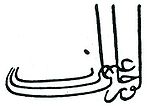 |
Mal Hatun Malhun Hatun, Mal Hatun, Mala Hatun, Mâl Hatun ya da Bala Hatun was the wife of Osman I, Valide Sultan. It has been recognized by many historians that she was the daughter of the Anatolian Turkish Bey, Ömer Bey, although there had been some speculations that she was the daughter of Sheik... ; |
|
| 3 | Murad I Murad I Murad I was the Sultan of the Ottoman Empire, from 1361 to 1389... HÜDAVENDİGÂR - Khodāvandgār (The God-like One) ŞEHÎD (Shāhīd) (Sultan since 1383) |
1362 | 15 June 1389 Battle of Kosovo The Battle of Kosovo took place on St. Vitus' Day, June 15, 1389, between the army led by Serbian Prince Lazar Hrebeljanović, and the invading army of the Ottoman Empire under the leadership of Sultan Murad I... |
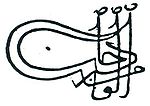 |
|
|
| 4 | Bayezid I Bayezid I Bayezid I was the Sultan of the Ottoman Empire, from 1389 to 1402. He was the son of Murad I and Valide Sultan Gülçiçek Hatun.-Biography:Bayezid was born in Edirne and spent his youth in Bursa, where he received a high-level education... YILDIRIM (The Thunderbolt) |
 |
15 June 1389 Battle of Kosovo The Battle of Kosovo took place on St. Vitus' Day, June 15, 1389, between the army led by Serbian Prince Lazar Hrebeljanović, and the invading army of the Ottoman Empire under the leadership of Sultan Murad I... |
20 July 1402 Battle of Ankara The Battle of Ankara or Battle of Angora, fought on July 20, 1402, took place at the field of Çubuk between the forces of the Ottoman sultan Bayezid I and the Turko-Mongol forces of Timur, ruler of the Timurid Empire. The battle was a major victory for Timur, and it led to a period of crisis for... |
 |
Gülçiçek Hatun Gülçiçek Hatun was the wife of Ottoman Sultan Murad I and Valide Sultan to their son Bayezid I. She was of Greek descent.-See also:*Ottoman family tree*Ottoman Dynasty... ; Battle of Ankara The Battle of Ankara or Battle of Angora, fought on July 20, 1402, took place at the field of Çubuk between the forces of the Ottoman sultan Bayezid I and the Turko-Mongol forces of Timur, ruler of the Timurid Empire. The battle was a major victory for Timur, and it led to a period of crisis for... (de facto end of reign); Aksehir Akşehir is a town and district of Konya Province in the Central Anatolia region of Turkey. According to 2000 census, population of the district is 114,918 of which 63,000 live in the town of Akşehir... on 8 March 1403. |
(20 July 1402
Battle of Ankara
The Battle of Ankara or Battle of Angora, fought on July 20, 1402, took place at the field of Çubuk between the forces of the Ottoman sultan Bayezid I and the Turko-Mongol forces of Timur, ruler of the Timurid Empire. The battle was a major victory for Timur, and it led to a period of crisis for...
– 5 July 1413
Musa Çelebi
Musa Çelebi was an Ottoman prince and a co-ruler of the empire for three years during Ottoman Interregnum. - Background :...
)
|-
| —
| İsa Çelebi
İsa Çelebi
İsa Çelebi was an Ottoman prince and a co-ruler of the empire during the Ottoman Interregnum. -Background:...
The Co-Sultan of Anatolia
Anatolia
Anatolia is a geographic and historical term denoting the westernmost protrusion of Asia, comprising the majority of the Republic of Turkey...
|
| 1403
| 1405
| —
| align="left" |
- After the Battle of AnkaraBattle of AnkaraThe Battle of Ankara or Battle of Angora, fought on July 20, 1402, took place at the field of Çubuk between the forces of the Ottoman sultan Bayezid I and the Turko-Mongol forces of Timur, ruler of the Timurid Empire. The battle was a major victory for Timur, and it led to a period of crisis for...
on July 20, 1402, İsa Çelebiİsa Çelebiİsa Çelebi was an Ottoman prince and a co-ruler of the empire during the Ottoman Interregnum. -Background:...
defeated Musa ÇelebiMusa ÇelebiMusa Çelebi was an Ottoman prince and a co-ruler of the empire for three years during Ottoman Interregnum. - Background :...
and began controlling the western part of Anatolian territory of the empire for approximately two years. - Defeated by Mehmed Çelebi in the battle of Ulubat in 1405.
- Murdered in 1406.
|-
| —
| Emir (Amir)
Süleyman Çelebi
Süleyman Çelebi
Süleyman Çelebi was an Ottoman prince and a co-ruler of the empire for several years during the Ottoman Interregnum. - Back ground :...
The First Sultan of Rumelia
Rumelia
Rumelia was an historical region comprising the territories of the Ottoman Empire in Europe...
|
| 20 July 1402
Battle of Ankara
The Battle of Ankara or Battle of Angora, fought on July 20, 1402, took place at the field of Çubuk between the forces of the Ottoman sultan Bayezid I and the Turko-Mongol forces of Timur, ruler of the Timurid Empire. The battle was a major victory for Timur, and it led to a period of crisis for...
| 17 February 1411
| —
| align="left" |
- Acquired the title of The Sultan of RumeliaRumeliaRumelia was an historical region comprising the territories of the Ottoman Empire in Europe...
for the European portion of the empire, a short period after the Ottoman defeat of The Battle of Ankara on 20 July 1402Battle of AnkaraThe Battle of Ankara or Battle of Angora, fought on July 20, 1402, took place at the field of Çubuk between the forces of the Ottoman sultan Bayezid I and the Turko-Mongol forces of Timur, ruler of the Timurid Empire. The battle was a major victory for Timur, and it led to a period of crisis for... - Murdered on 17 February 1411.
|-
| —
| Musa Çelebi
Musa Çelebi
Musa Çelebi was an Ottoman prince and a co-ruler of the empire for three years during Ottoman Interregnum. - Background :...
The Second Sultan of Rumelia
Rumelia
Rumelia was an historical region comprising the territories of the Ottoman Empire in Europe...
|
| 18 February 1411
| 5 July 1413
| —
| align="left" |
- Acquired the title of The Sultan of RumeliaRumeliaRumelia was an historical region comprising the territories of the Ottoman Empire in Europe...
for the European portion of the empireon 18 February 1411, just after the death of Süleyman ÇelebiSüleyman ÇelebiSüleyman Çelebi was an Ottoman prince and a co-ruler of the empire for several years during the Ottoman Interregnum. - Back ground :...
. - Killed on 5 July 1413 by Mehmed Çelebi’s forces in the battle of Çamurlu Derbent near SamokovSamokovSamokov is a town in Sofia Province in the southwest of Bulgaria. It is situated in a kettle between the mountains Rila and Vitosha, 55 kilometres from the capital Sofia...
in BulgariaBulgariaBulgaria , officially the Republic of Bulgaria , is a parliamentary democracy within a unitary constitutional republic in Southeast Europe. The country borders Romania to the north, Serbia and Macedonia to the west, Greece and Turkey to the south, as well as the Black Sea to the east...
.
|-
| —
| Mehmed Çelebi
The Sultan of Anatolia
Anatolia
Anatolia is a geographic and historical term denoting the westernmost protrusion of Asia, comprising the majority of the Republic of Turkey...
|
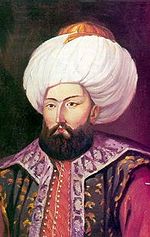
(Sultan of the Eastern Anatolian Territory)
1406 - 1413
(The Sultan of Anatolia
Anatolia
Anatolia is a geographic and historical term denoting the westernmost protrusion of Asia, comprising the majority of the Republic of Turkey...
)
| 5 July 1413
Musa Çelebi
Musa Çelebi was an Ottoman prince and a co-ruler of the empire for three years during Ottoman Interregnum. - Background :...
| —
| align="left" |
- Acquired the control of the eastern part of the Anatolian territory as the Co-Sultan just after the defeat of the Battle of AnkaraBattle of AnkaraThe Battle of Ankara or Battle of Angora, fought on July 20, 1402, took place at the field of Çubuk between the forces of the Ottoman sultan Bayezid I and the Turko-Mongol forces of Timur, ruler of the Timurid Empire. The battle was a major victory for Timur, and it led to a period of crisis for...
on 20 July 1402. - Defeated İsa Çelebiİsa Çelebiİsa Çelebi was an Ottoman prince and a co-ruler of the empire during the Ottoman Interregnum. -Background:...
in the battle of Ulubat in 1405. - Became the sole ruler of the Anatolian territory of the Ottoman EmpireOttoman EmpireThe Ottoman EmpireIt was usually referred to as the "Ottoman Empire", the "Turkish Empire", the "Ottoman Caliphate" or more commonly "Turkey" by its contemporaries...
upon İsa’s death in 1406. - Acquired the title of Ottoman Sultan Mehmed I KhanMehmed IMehmed I Çelebi was a Sultan of the Ottoman Empire from 1413 to 1421. He was one of the sons of Bayezid I and Valide Sultan Devlet Hatun Mehmed I Çelebi (Ottoman: چلبی محمد, Mehmed I or Mehmed Çelebi) (1382, Bursa – May 26, 1421, Edirne, Ottoman Empire) was a Sultan of the Ottoman Empire...
upon MusaMusa ÇelebiMusa Çelebi was an Ottoman prince and a co-ruler of the empire for three years during Ottoman Interregnum. - Background :...
’s death on 5 July 1413.
|-
| colspan=7 style="background:#B9B9B9" | Rise of the Ottoman Empire
Rise of the Ottoman Empire
The Foundation and Rise of the Ottoman Empire refers to the period which started with the weakening of the Seljuq Sultanate of Rûm in the very early 14th century and ended with the Byzantine Empire decline and the Fall of Constantinople on May 29, 1453.The rise of the Ottomans correlates with the...
(5 July 1413
Musa Çelebi
Musa Çelebi was an Ottoman prince and a co-ruler of the empire for three years during Ottoman Interregnum. - Background :...
– 29 May 1453
Fall of Constantinople
The Fall of Constantinople was the capture of the capital of the Byzantine Empire, which occurred after a siege by the Ottoman Empire, under the command of Ottoman Sultan Mehmed II, against the defending army commanded by Byzantine Emperor Constantine XI...
)
|-
| 5
| Mehmed I
Mehmed I
Mehmed I Çelebi was a Sultan of the Ottoman Empire from 1413 to 1421. He was one of the sons of Bayezid I and Valide Sultan Devlet Hatun Mehmed I Çelebi (Ottoman: چلبی محمد, Mehmed I or Mehmed Çelebi) (1382, Bursa – May 26, 1421, Edirne, Ottoman Empire) was a Sultan of the Ottoman Empire...
ÇELEBİ (The Affable)
KİRİŞÇİ (lit. The Bowstring Maker for his support)
|
| 5 July 1413
Musa Çelebi
Musa Çelebi was an Ottoman prince and a co-ruler of the empire for three years during Ottoman Interregnum. - Background :...
| 26 May 1421
|

- Son of Bayezid I and Devlet KhātûnDevlet HatunDevlet Hatun was the wife of Ottoman Sultan Bayezid I, the daughter of Yakub Shah of Germiyanids, the descendant of Rumi through his son Sultan Walad’s daughter Mutahhara Hatun who was an ancestor of Yakub Shah. She was the mother of Ottoman Sultan Mehmed I, and İsa Çelebi, Governor of Anatolia...
; - Reigned until his death.
|-
| 6
| Murad II
Murad II
Murad II Kodja was the Sultan of the Ottoman Empire from 1421 to 1451 ....
KOCA (The Great)
|
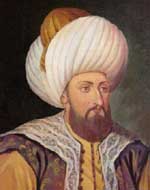
| 1444
|

- Son of Mehmed I and Âminā (Emine) KhātûnEmine HatunEmîne Khātûn was the wife of Ottoman Sultan Mehmed I and Valide Sultan to their son Murad II and the grandmother of Mehmed II.-Biography:...
; - Abdicated of his own free will in favour of his son Mehmed IIMehmed IIMehmed II , was Sultan of the Ottoman Empire for a short time from 1444 to September 1446, and later from...
.
|-
| 7
| Mehmed II
Mehmed II
Mehmed II , was Sultan of the Ottoman Empire for a short time from 1444 to September 1446, and later from...
FATİH (The Conqueror)
|
| 1444
| 1446
|

- Son of Murad II and Hadice Âlime Hūmâ KhātûnHuma HatunHatice Âlime Hümâ Khātûn , Valide Sultan wife of Murad II and mother of Mehmed II, the Ottoman Sultan was born in the Devrekani county of Kastamonu Province in modern day Turkey...
; - Surrendered the throne to his father after having asked him to return to power.
|-
| —
| Murad II
Murad II
Murad II Kodja was the Sultan of the Ottoman Empire from 1421 to 1451 ....
KOCA (The Great)
|
| 1446
| 3 February 1451
|

- Second reign;
- Forced to return to the throne following a JanissaryJanissaryThe Janissaries were infantry units that formed the Ottoman sultan's household troops and bodyguards...
insurgence; - Reigned until his death.
|-
| colspan=7 style="background:#B9B9B9" | Growth of the Ottoman Empire
Growth of the Ottoman Empire
The Growth of the Ottoman Empire is the period followed after the Rise of the Ottoman Empire in which the Ottoman state reached the Pax Ottomana. In this period, the Ottoman Empire expanded southwestwards into North Africa and battled with the re-emergent Persian Shi'ia Safavid Empire to the east...
(29 May 1453
Fall of Constantinople
The Fall of Constantinople was the capture of the capital of the Byzantine Empire, which occurred after a siege by the Ottoman Empire, under the command of Ottoman Sultan Mehmed II, against the defending army commanded by Byzantine Emperor Constantine XI...
– 11/12 September 1683
Battle of Vienna
The Battle of Vienna took place on 11 and 12 September 1683 after Vienna had been besieged by the Ottoman Empire for two months...
)
|-
| —
| Mehmed II
Mehmed II
Mehmed II , was Sultan of the Ottoman Empire for a short time from 1444 to September 1446, and later from...
FATİH (The Conqueror)
|
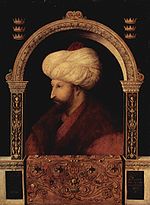
| 3 May 1481
|

- Second reign;
- Conquered ConstantinopleFall of ConstantinopleThe Fall of Constantinople was the capture of the capital of the Byzantine Empire, which occurred after a siege by the Ottoman Empire, under the command of Ottoman Sultan Mehmed II, against the defending army commanded by Byzantine Emperor Constantine XI...
in 1453; - Reigned until his death.
|-
| 8
| Bayezid II
Bayezid II
Bayezid II or Sultân Bayezid-î Velî was the oldest son and successor of Mehmed II, ruling as Sultan of the Ottoman Empire from 1481 to 1512...
VELÎ (The Saint)
|
| 19 May 1481
| 25 April 1512
|

- Son of Mehmed II and Mükrîme (Sitt-î Mū’kārîmā) KhātûnMükrime Hatun300px|thumb|left|The son of Mükrime Hatun, II. BayezidMûkrîmā Khātûn, , was the third wife of Ottoman Sultan Mehmed II, the daughter of Süleyman Bey, the sixth ruler of Dulkadir State, and the biological mother of the Ottoman Sultan Bayezid II...
; - Abdicated;
- Died near DidymoteichoDidymoteichoDidymóteicho is a town located in the eastern part of the Evros peripheral unit of Thrace, Greece. It is the seat of the municipality of the same name. The town sits on a plain and located south east of Svilengrad, south of Edirne, Turkey and Orestiada, west of Uzunköprü, about 20 km north...
on 26 May 1512.
|-
| 9
| Selim I
Selim I
Selim I, Yavuz Sultân Selim Khan, Hâdim-ül Haramain-ish Sharifain , nicknamed Yavuz "the Stern" or "the Steadfast", but often rendered in English as "the Grim" , was the Sultan of the Ottoman Empire from 1512 to...
YAVUZ (The Stern)
(Caliph Of Muslims Since 1517)
|
| 25 April 1512
| 21 September 1520
|

- Son of Bayezid II and Kül-Bahār KhātûnGülbahar SultanKül-Bahār Sultan , was the wife of Ottoman Sultan Bayezid II and the mother of Selim I. Little is known of her family background, apart from the fact that an Ottoman inscription describes her as Khātun binti Abd-us-Samed , which implied that her father had possibly converted to Islam Kül-Bahār...
; - Reigned until his death.
|-
| 10
| Suleiman I
Suleiman the Magnificent
Suleiman I was the tenth and longest-reigning Sultan of the Ottoman Empire, from 1520 to his death in 1566. He is known in the West as Suleiman the Magnificent and in the East, as "The Lawgiver" , for his complete reconstruction of the Ottoman legal system...
MUHTEŞEM (The Magnificent)
or
KANÛNÎ (The Lawgiver)
|
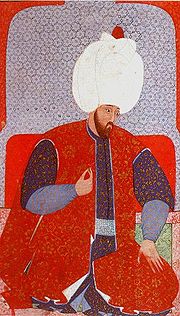
| 6 or 7 September 1566
|

- Son of Selim I and A’ishā Hafīzā (Ayşe Hafsa) Vâlidā Sultân;
- Reigned until his death.
|-
| 11
| Selim II
Selim II
Selim II Sarkhosh Hashoink , also known as "Selim the Sot " or "Selim the Drunkard"; and as "Sarı Selim" or "Selim the Blond", was the Sultan of the Ottoman Empire from 1566 until his death in 1574.-Early years:He was born in Constantinople a son of Suleiman the...
SARI (The Yellow-The Blond)
|
| 29 September 1566
| 21 December 1574
|
| align="left" |
- Son of Suleiman I and Hürrem (Khūrrām or Kārimā) Haseki Sultân;
- Reigned until his death.
|-
| 12
| Murad III
Murad III
Murad III was the Sultan of the Ottoman Empire from 1574 until his death.-Biography:...
|
| 22 December 1574
| 16 January 1595
|

- Son of Selim II and Afîfe Nûr-Bānû Vâlidā Sultân;
- Reigned until his death.
|-
| 13
| Mehmed III
Mehmed III
Mehmed III Adli was sultan of the Ottoman Empire from 1595 until his death.-Biography:...
ADLÎ (The Just)
|
| 27 January 1595
| 20 or 21 December 1603
|

- Son of Murad III and Sâfiyā Vâlidā SultânSafiye SultanSafiyā Valida Sultânā, , née Sofia Baffo, , was the consort of Ottoman Sultan Murad III, the Valida Sultânā and de facto co-regent to her son, Ottoman Sultan Mehmed III.- Biography :She was of Venetian descent...
; - Reigned until his death;
|-
| 14
| Ahmed I
Ahmed I
Ahmed I or Ahmed Bakhti was the Sultan of the Ottoman Empire from 1603 until his death in 1617.-Biography:...
BAKHTÎ (The Fortunate)
|
| 21 December 1603
| 22 November 1617
|

- Son of Mehmed III and Handan Vâlidā SultânHandan SultanHandan Sultâna or Devletlu İsmetlu Handan Valide Sultan Aliyyetü'ş-Şân Hazretleri was the mother of the Ottoman Sultan Ahmed I and his Valide Sultan from 21 December 1603 until 26 November 1605...
; - Reigned until his death.
|-
| 15
| Mustafa I
Mustafa I
Mustafa I Deli , son of Mehmed III, was the Sultan of the Ottoman Empire from 1617 to 1618 and from 1622 to 1623. His mother was Valide Sultan Handan Sultan, an ethnic Greek originally named Helena....
DELİ (The Intestable)
Intellectual disability
Intellectual disability is a broad concept encompassing various intellectual deficits, including mental retardation , deficits too mild to properly qualify as MR, various specific conditions , and problems acquired later in life through acquired brain injuries or neurodegenerative diseases like...
|
| 22 November 1617
| 26 February 1618
|

- Son of Mehmed III and Fûldâne Valide Sultan;
- Deposed due to his non-syndromic mental retardationIntellectual disabilityIntellectual disability is a broad concept encompassing various intellectual deficits, including mental retardation , deficits too mild to properly qualify as MR, various specific conditions , and problems acquired later in life through acquired brain injuries or neurodegenerative diseases like...
in favour of his young nephew Osman IIOsman IISultan Osman II or Othman II was the Sultan of the Ottoman Empire from 1618 until his death on 20 May 1622...
.
|-
| 16
| Osman II
Osman II
Sultan Osman II or Othman II was the Sultan of the Ottoman Empire from 1618 until his death on 20 May 1622...
GENÇ (The Young)
ŞEHÎD (Shāhīd)
|
| 26 February 1618
| 19 May 1622
|

- Son of Ahmed I and Mâh-Firûze Hadice (Khadija) Vâlidā SultânMahfiruze HaticeMâh-Firûze Hadice Valide Sultan, Devletlu İsmetlu Mâh-Firûze Hadice Valide Sultan Ahiyât üs-Şan Hazretleri . Her original name was Maria, she was the spouse of Ahmed I, and mother of Osman II. Mâh-Firûze Hadice was of Greek descent....
; - Deposed in a JanissaryJanissaryThe Janissaries were infantry units that formed the Ottoman sultan's household troops and bodyguards...
riot on 19 May 1622; - Murdered on 20 May 1622 by the Grand VizierGrand VizierGrand Vizier, in Turkish Vezir-i Azam or Sadr-ı Azam , deriving from the Arabic word vizier , was the greatest minister of the Sultan, with absolute power of attorney and, in principle, dismissable only by the Sultan himself...
Kara Davud Paşa (Black Da'ud Pasha) from compression of his testicles.
|-
| —
| Mustafa I
Mustafa I
Mustafa I Deli , son of Mehmed III, was the Sultan of the Ottoman Empire from 1617 to 1618 and from 1622 to 1623. His mother was Valide Sultan Handan Sultan, an ethnic Greek originally named Helena....
DELİ (The Intestable)
Intellectual disability
Intellectual disability is a broad concept encompassing various intellectual deficits, including mental retardation , deficits too mild to properly qualify as MR, various specific conditions , and problems acquired later in life through acquired brain injuries or neurodegenerative diseases like...
|
| 20 May 1622
| 10 September 1623
|

- Second reign;
- Returned to the throne after the assassination of his nephew Osman IIOsman IISultan Osman II or Othman II was the Sultan of the Ottoman Empire from 1618 until his death on 20 May 1622...
; - Deposed due to his syndromic mental retardationIntellectual disabilityIntellectual disability is a broad concept encompassing various intellectual deficits, including mental retardation , deficits too mild to properly qualify as MR, various specific conditions , and problems acquired later in life through acquired brain injuries or neurodegenerative diseases like...
and confined until his death in IstanbulIstanbulIstanbul , historically known as Byzantium and Constantinople , is the largest city of Turkey. Istanbul metropolitan province had 13.26 million people living in it as of December, 2010, which is 18% of Turkey's population and the 3rd largest metropolitan area in Europe after London and...
on 20 January 1639.
|-
| 17
| Murad IV
Murad IV
Murad IV Ghazi was the Sultan of the Ottoman Empire from 1623 to 1640, known both for restoring the authority of the state and for the brutality of his methods...
SAHİB-Î KIRAN
The Conqueror of Baghdad
Baghdad
Baghdad is the capital of Iraq, as well as the coterminous Baghdad Governorate. The population of Baghdad in 2011 is approximately 7,216,040...
GHAZI (The Warrior)
|
| 10 September 1623
| 8 or 9 February 1640
|

- Son of Ahmed I and Mâh-Peyker Kösem Vâlidā SultânKösemKösem Sultan — also known as Mehpeyker Sultan — was one of the most powerful women in Ottoman history . Consort and favourite concubine of Ottoman Sultan Ahmed I...
; - Reigned until his death.
|-
| 18
| Ibrahim I
Ibrahim I
Ibrahim I was the Sultan of the Ottoman Empire from 1640 until 1648. He was born in Istanbul the son of Ahmed I by Valide Sultan Kadinefendi Kösem Sultan, an ethnic Greek originally named Anastasia...
DELİ (The Arrage)
Anxiety disorder
Anxiety disorder is a blanket term covering several different forms of abnormal and pathological fear and anxiety. Conditions now considered anxiety disorders only came under the aegis of psychiatry at the end of the 19th century. Gelder, Mayou & Geddes explains that anxiety disorders are...
The Conqueror of Crete
Crete
Crete is the largest and most populous of the Greek islands, the fifth largest island in the Mediterranean Sea, and one of the thirteen administrative regions of Greece. It forms a significant part of the economy and cultural heritage of Greece while retaining its own local cultural traits...
ŞEHÎD (Shāhīd)
|
| 9 February 1640
| 8 August 1648
|

- Son of Ahmed I and Mâh-Peyker Kösem Vâlidā SultânKösemKösem Sultan — also known as Mehpeyker Sultan — was one of the most powerful women in Ottoman history . Consort and favourite concubine of Ottoman Sultan Ahmed I...
; - Deposed on 8 August 1648 in a coupCoup d'étatA coup d'état state, literally: strike/blow of state)—also known as a coup, putsch, and overthrow—is the sudden, extrajudicial deposition of a government, usually by a small group of the existing state establishment—typically the military—to replace the deposed government with another body; either...
led by the Sheikh ul-IslamSheikh ul-IslamShaykh al-Islām is a title of superior authority in the issues of Islam....
; - Strangled in IstanbulIstanbulIstanbul , historically known as Byzantium and Constantinople , is the largest city of Turkey. Istanbul metropolitan province had 13.26 million people living in it as of December, 2010, which is 18% of Turkey's population and the 3rd largest metropolitan area in Europe after London and...
on 18 August 1648 at the behest of the Grand VizierGrand VizierGrand Vizier, in Turkish Vezir-i Azam or Sadr-ı Azam , deriving from the Arabic word vizier , was the greatest minister of the Sultan, with absolute power of attorney and, in principle, dismissable only by the Sultan himself...
Mevlevî Mehmed Paşa (Sofu Mehmed Pasha).
|-
| 19
| Mehmed IV
Mehmed IV
Mehmed IV Modern Turkish Mehmet was the Sultan of the Ottoman Empire from 1648 to 1687...
AVCI (The Hunter)
|
| 8 August 1648
| 8 November 1687
|

- Son of Ibrahim I and Turhan Hadice (Khadija) Vâlidā Sultân;
- Deposed on 8 November 1687 following the Ottoman defeat at the Second Battle of MohácsBattle of Mohács (1687)The Second Battle of Mohács, also known as the Battle of 'Berg Harsány', was fought between the forces of Ottoman Sultan Mehmed IV, commanded by the Grand-Vizier Sari Süleyman Paşa, and the forces of Holy Roman Emperor Leopold I, commanded by Charles of Lorraine...
; - Died in EdirneEdirneEdirne is a city in Eastern Thrace, the northwestern part of Turkey, close to the borders with Greece and Bulgaria. Edirne served as the capital city of the Ottoman Empire from 1365 to 1453, before Constantinople became the empire's new capital. At present, Edirne is the capital of the Edirne...
on 6 January 1693.
|-
| colspan=7 style="background:#B9B9B9" | Stagnation of the Ottoman Empire
Stagnation of the Ottoman Empire
The Stagnation of the Ottoman Empire is the period following the Growth of the Ottoman Empire . During this period the empire continued to have military might. The next period would be shaped by the decline of their military power which followed the loss of huge territories...
(11/12 September 1683
Battle of Vienna
The Battle of Vienna took place on 11 and 12 September 1683 after Vienna had been besieged by the Ottoman Empire for two months...
– 20 October 1827
Battle of Navarino
The naval Battle of Navarino was fought on 20 October 1827, during the Greek War of Independence in Navarino Bay , on the west coast of the Peloponnese peninsula, in the Ionian Sea. A combined Ottoman and Egyptian armada was destroyed by a combined British, French and Russian naval force...
)
|-
| 20
| Suleiman II
Suleiman II
Suleiman II was the Sultan of the Ottoman Empire from 1687 to 1691...
GHAZI (The Warrior)
|
| 8 November 1687
| 22 June 1691
|

- Son of Ibrahim I and Sâliha Dil-Âşûb (Dilâshûb) Vâlidā Sultân;
- Reigned until his death.
|-
| 21
| Ahmed II
Ahmed II
Ahmed II Khan Ghazi was the Sultan of the Ottoman Empire from 1691 to 1695...
KHAN GHAZI (The Warrior Prince)
|
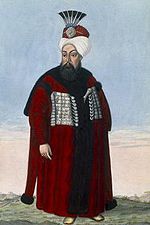
| 6 February 1695
|

- Son of Ibrahim I and Hatice (Khadija) Mû’azzez İkinci Haseki Sultân;
- Reigned until his death.
|-
| 22
| Mustafa II
Mustafa II
Mustafa II Ghazi was the Sultan of the Ottoman Empire from 1695 to 1703.-Life:...
GHAZI (The Warrior)
|
| 6 February 1695
| 22 August 1703
|

- Son of Mehmed IV and Mâh-Pârā Ummetullah (Emetullah) Râbi’a Gül-Nûsh (Gül-Nûş) Vâlidā Sultân;
- Deposed on 22 August 1703 by reason of the JanissaryJanissaryThe Janissaries were infantry units that formed the Ottoman sultan's household troops and bodyguards...
uprising known as the Edirne EventEdirne eventThe Edirne event was a chain of events in 1703 in the Ottoman Empire, which resulted in dethroning of Sultan Mustafa II.-Background:By the Treaty of Karlowitz , Ottoman Empire had to cede vast territories to Holy League countries. It was clear that both the army and the civil institutions had to be...
; - Died in Istanbul on 8 January 1704.
|-
| 23
| Ahmed III
Ahmed III
Ahmed III was Sultan of the Ottoman Empire and a son of Sultan Mehmed IV . His mother was Mâh-Pâre Ummatullah Râbi'a Gül-Nûş Valide Sultan, originally named Evmania Voria, who was an ethnic Greek. He was born at Hajioglupazari, in Dobruja...
Tulip Era
Tulip Era in the Ottoman Empire
The Tulip Period or Tulip Era is a period in Ottoman history from The Treaty of Passarowitz on 21 July 1718 to The Patrona Halil Rebellion on 28 September 1730...
Sultan
Sultan
Sultan is a title with several historical meanings. Originally, it was an Arabic language abstract noun meaning "strength", "authority", "rulership", and "dictatorship", derived from the masdar سلطة , meaning "authority" or "power". Later, it came to be used as the title of certain rulers who...
GHAZI (The Warrior)
|

| 1 or 2 October 1730
|

- Son of Mehmed IV and Mâh-Pârā Ummetullah (Emetullah) Râbi’a Gül-Nûsh (Gül-Nûş) Vâlidā Sultân;
- Deposed in consequence of the JanissaryJanissaryThe Janissaries were infantry units that formed the Ottoman sultan's household troops and bodyguards...
rebellion led by Patrona HalilPatrona HalilPatrona Halil , was the instigator of a mob uprising in 1730 which replaced Sultan Ahmed III with Mahmud I and ended the Tulip period....
; - Died on 1 July 1736.
|-
| 24
| Mahmud I
Mahmud I
Mahmud I , called the Hunchback was the Sultan of the Ottoman Empire from 1730 to 1754.-Biography:...
GHAZI (The Warrior)
KAMBUR (The Hunchback)
|
| 2 October 1730
| 13 December 1754
|
| align="left" |
- Son of Mustafa II and Sâliha Sebkat-î Vâlidā Sultân;
- Reigned until his death.
|-
| 25
| Osman III
Osman III
Osman III or Othman IIIText not available was the Sultan of the Ottoman Empire from 1754 to 1757.-Biography:...
SOFU (The Devout)
|
| 13 December 1754
| 29 or 30 October 1757
|

- Son of Mustafa II and Şâh-Süvar (Shah-Sûvar) Vâlidā Sultân;
- Reigned until his death.
|-
| 26
| Mustafa III
Mustafa III
Mustafa III was the Sultan of the Ottoman Empire from 1757 to 1774. He was a son of Sultan Ahmed III and was succeeded by his brother Abdul Hamid I . He was born in Edirne...
YENİLİKÇİ (The First Innovative)
|
| 30 October 1757
| 21 January 1774
|

- Son of Ahmed III and Âminā Mehr-î-Shâh (Emine Mihr-î-Şâh) İkinci Kadın EfendiAmina Mihr-i ShahAmina Mihr-i Shah .-Biography:She was the French second spouse of Ottoman Sultan Ahmed III, and the mother of Mustafa III....
; - Reigned until his death.
|-
| 27
| Abdülhamid I
Abd ūl-Hāmīd (The Servant of God)
ISLAHATÇI (The Improver)
GHAZI (The Warrior)
|
| 21 January 1774
| 6 or 7 April 1789
|

- Son of Ahmed III and Râbi’a Sharm-î (Şerm-î) Kadın EfendiRabiâ SultanRabia Sultan Kadın Sultân]) .-Biography:Rabia Sultan was born as Ida in France or Circassia, initially the third and then the second French or Circassian spouse of Ottoman Sultan Ahmed III. She was the mother of Sultan Abdul Hamid I...
; - Reigned until his death.
|-
| 28
| Selim III
Selim III
Selim III was the reform-minded Sultan of the Ottoman Empire from 1789 to 1807. The Janissaries eventually deposed and imprisoned him, and placed his cousin Mustafa on the throne as Mustafa IV...
BESTEKÂR (The Composer)
NİZÂM-Î (Regulative - Orderly)
ŞEHÎD (Shāhīd)
|
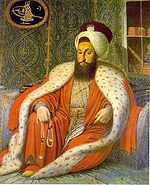
| 29 May 1807
|

- Son of Mustafa III and Mehr-î-Shâh (Mihr-î-Şâh) Vâlidā Sultân;
- Deposed as a result of the Janissary revolt led by Kabakçı MustafaKabakçı MustafaKabakçı Mustafa was a rebel leader who caused the delay of Ottoman reformation in the early 19th century.-Yamaks and Kabakçı:Yamaks were a special class of soldiers who were responsible in defending Bosphorous against Cossack pirates from Ukraine. Unlike janissaries they were from Black Sea Region...
against his reforms; - Assassinated in Istanbul on 28 July 1808 at the behest of Ottoman Sultan Mustafa IVMustafa IVMustafa IV was sultan of the Ottoman Empire from 1807 to 1808.-Biography:...
.
|-
| 29
| Mustafa IV
Mustafa IV
Mustafa IV was sultan of the Ottoman Empire from 1807 to 1808.-Biography:...
|
| 29 May 1807
| 28 July 1808
|

- Son of Abdülhamid I and Bash Iqbal Nushatzaza (Nüzhet-Zâdāh / Nükhet-Sedâ) Khānūm Effendi;
- Deposed in an insurrection led by Alemdar Mustafa PashaAlemdar Mustafa PashaAlemdar Mustafa Pasha was an Ottoman military commander and a Grand Vizier born in Khotyn in Turkish-occupied Ukraine in 1765...
; - Executed in Istanbul on 17 November 1808 by order of Ottoman Sultan Mahmud IIMahmud IIMahmud II was the 30th Sultan of the Ottoman Empire from 1808 until his death in 1839. He was born in the Topkapi Palace, Istanbul, the son of Sultan Abdulhamid I...
.
|-
| 30
| Mahmud II
Mahmud II
Mahmud II was the 30th Sultan of the Ottoman Empire from 1808 until his death in 1839. He was born in the Topkapi Palace, Istanbul, the son of Sultan Abdulhamid I...
İNKILÂPÇI (The Reformer)
GHAZI (The Warrior)
|
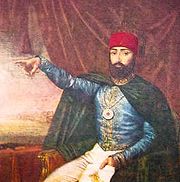
| 1 July 1839
|

- Son of Abdülhamid I and Naksh-î-Dil (Nakş-î-Dil) Haseki Vâlidā Sultân (adoptive mother of Mahmud II);
- Disbanded the Janissaries in consequence of the Auspicious EventThe Auspicious IncidentThe Auspicious Incident was the forced disbandment of the centuries-old Janissary corps by Ottoman sultan Mahmud II in June 1826....
in 1826; - Reigned until his death.
|-
| colspan=7 style="background:#B9B9B9" | Decline of the Ottoman Empire
Decline of the Ottoman Empire
The Decline of the Ottoman Empire is the period that followed after the Stagnation of the Ottoman Empire in which the empire experienced several economic and political setbacks. Directly affecting the Empire at this time was Russian imperialism...
(20 October 1827
Battle of Navarino
The naval Battle of Navarino was fought on 20 October 1827, during the Greek War of Independence in Navarino Bay , on the west coast of the Peloponnese peninsula, in the Ionian Sea. A combined Ottoman and Egyptian armada was destroyed by a combined British, French and Russian naval force...
– 24 July 1908
Second Constitutional Era (Ottoman Empire)
The Second Constitutional Era of the Ottoman Empire began shortly after Sultan Abdülhamid II restored the constitutional monarchy after the 1908 Young Turk Revolution. The period established many political groups...
)
|-
| 31
| Abdülmecid I
Abdülmecid I
Sultan Abdülmecid I, Abdul Mejid I, Abd-ul-Mejid I or Abd Al-Majid I Ghazi was the 31st Sultan of the Ottoman Empire and succeeded his father Mahmud II on July 2, 1839. His reign was notable for the rise of nationalist movements within the empire's territories...
TANZİMÂTÇI
(The Strong Reformist or
The Advocate of Reorganization)
GHAZI (The Warrior)
|

| 25 June 1861
|

- Son of Mahmud II and Bezm-î-Âlem Vâlidā SultânBezmiâlemBezmiâlem Kadınefendi was the second spouse of Sultan Mahmud II of the Ottoman Empire.-Biography:...
; - Proclaimed the Hatt-ı Sharif (Imperial Edict) of Gülhane (Tanzimât Fermânı)Hatt-i SharifThe Hatt-i Sharif of Gülhane or Tanzimât Fermânı was an 1839 proclamation by Ottoman Sultan Abdülmecid I that launched the Tanzimât period of reforms and reorganization....
that launched the TanzimatTanzimatThe Tanzimât , meaning reorganization of the Ottoman Empire, was a period of reformation that began in 1839 and ended with the First Constitutional Era in 1876. The Tanzimât reform era was characterized by various attempts to modernize the Ottoman Empire, to secure its territorial integrity against...
period of reforms and reorganization on 3 November 1839 at the behest of reformist Grand VizierGrand VizierGrand Vizier, in Turkish Vezir-i Azam or Sadr-ı Azam , deriving from the Arabic word vizier , was the greatest minister of the Sultan, with absolute power of attorney and, in principle, dismissable only by the Sultan himself...
Great Mustafa Rashid PashaKoca Mustafa Resid PashaMustafa Reshid Pasha was an Ottoman statesman and diplomat.Born in Istanbul, he entered the public service at an early age and rose rapidly, becoming ambassador in Paris and in London , minister for foreign affairs , again ambassador in London , and in Paris . Appointed governor of Adrianople in...
; - Accepted the Islâhat Hatt-ı Hümayun (Imperial Reform Edict) (Islâhat Fermânı)Hatt-i humayunHatt-i humayun , also known as hatt-i sharif , is the diplomatics term for a document or handwritten note of an official nature by an Ottoman Sultan. The terms come from hatt , hümayun and şerif...
on 18 February 1856; - Reigned until his death.
|-
| 32
| Abdülaziz I
BAHTSIZ (The Unfortunate)
ŞEHÎD (Shāhīd)
|
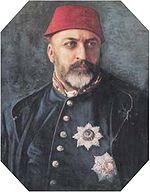
| 30 May 1876
|

- Son of Mahmud II and Pertav-Nihâl (Pertevniyâl) Vâlidā Sultân;
- Deposed by his ministers;
- Found dead (suicide or murder) five days later.
|-
| 33
| Mehmed Murad V
Murad V
Murad V was the 33rd Sultan of the Ottoman Empire who reigned from 30 May to 31 August 1876.He was born at Istanbul , Topkapı Palace. His father was Abdülmecid I...
|
| 30 May 1876
| 31 August 1876
|
| align="left" |
- Son of Abdülmecid I and Shāvk-Efzâ (Şevk-Efzâ) Vâlidā Sultân;
- Deposed due to his efforts to implement democratic reforms in the empire;
- Ordered to reside in Çırağan PalaceÇiragan PalaceÇırağan Palace , a former Ottoman palace, is now a five-star hotel of the Kempinski Hotels chain. It is located on the European shore of the Bosporus between Beşiktaş and Ortaköy in Istanbul, Turkey.- History :...
where he died on 29 August 1904.
|-
| 34
| Abdülhamid II
Ulû Sultân Abd ūl-Hāmīd Khan
(The Sublime Khan)
|

| 27 April 1909
|
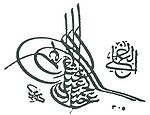
- Son of Abdülmecid I and Tîr-î-Müjgan Üçüncü Kadın Efendi; and later the adoptive son of Rahime Perestû (Piristû) Vâlidā SultânRahime PerestuRahîme Pirîstû , was the spouse of Ottoman Sultan Abdülmecid I, and adoptive mother and Valide sultan of Abdul Hamid II. She was of Circassian descent, and the biological daughter of Gogen Gök Bey of The Ubuh Tribe of Circassia, Ottoman Empire.Rahîme Pirîstû acquired the title of Valide Sultan to...
(adoptive mother of Abdul Hamid IIAbdul Hamid IIHis Imperial Majesty, The Sultan Abdülhamid II, Emperor of the Ottomans, Caliph of the Faithful was the 34th sultan of the Ottoman Empire...
). - Established the First Constitutional RuleFirst Constitutional Era (Ottoman Empire)The First Constitutional Era of the Ottoman Empire was the period of constitutional monarchy from the promulgation of the Kanûn-ı Esâsî , written by members of the Young Ottomans, on 23 November 1876 until 13 February 1878...
on 23 November 1876 and then suspended on 13 February 1878; - Restored the Second Constitutional RuleSecond Constitutional Era (Ottoman Empire)The Second Constitutional Era of the Ottoman Empire began shortly after Sultan Abdülhamid II restored the constitutional monarchy after the 1908 Young Turk Revolution. The period established many political groups...
on 3 July 1908; - Deposed after the 31 March Incident (on 13 April 1909)31 March IncidentThe 31 March Incident was a 1909 rebellion of reactionaries in İstanbul against the restoration of constitutional monarchy that had taken place in 1908. It took place on 13 April 1909...
; - Confined to Beylerbeyi PalaceBeylerbeyi PalaceThe Beylerbeyi Palace is located in the Beylerbeyi neighbourhood of Istanbul, Turkey at the Asian side of the Bosphorus...
where he died on 10 February 1918.
|-
| colspan=7 style="background:#B9B9B9" | Dissolution of the Ottoman Empire
Dissolution of the Ottoman Empire
The Dissolution of the Ottoman Empire included the watershed events of the Young Turk Revolution and the establishment of the Second Constitutional Era, and ended with the Partitioning of the Ottoman Empire by the victorious sides of World War I.- Establishment of the Second Constitutional Era, 24...
(24 July 1908
Second Constitutional Era (Ottoman Empire)
The Second Constitutional Era of the Ottoman Empire began shortly after Sultan Abdülhamid II restored the constitutional monarchy after the 1908 Young Turk Revolution. The period established many political groups...
– 30 October 1918
Armistice of Mudros
The Armistice of Moudros , concluded on 30 October 1918, ended the hostilities in the Middle Eastern theatre between the Ottoman Empire and the Allies of World War I...
)
|-
| 35
| Mehmed V
Mehmed V
Mehmed V Reshad was the 35th Ottoman Sultan. He was the son of Sultan Abdülmecid I. He was succeeded by his half-brother Mehmed VI.-Birth:...
REŞÂD (Rashād)
(The True Path Follower)
|
| 27 April 1909
| 3 July 1918
|
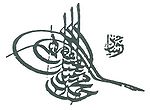
- Son of Abdülmecid I and Gül-Cemâl Dördüncü Kadın Efendi;
- Reigned as a figureheadFigureheadA figurehead is a carved wooden decoration found at the prow of ships largely made between the 16th and 19th century.-History:Although earlier ships had often had some form of bow ornamentation A figurehead is a carved wooden decoration found at the prow of ships largely made between the 16th and...
of Mehmed Talât, İsmail EnverIsmail EnverEnver Pasha or Ismail Enver Pasha , title was changed with his military ranks such as Enver Efendi , Enver Bey , Enver Pasha, higher than Mirliva) was an Ottoman military officer and a leader of the Young Turk revolution...
, and Ahmed Cemal (Djemal)Ahmed DjemalDjemal Pasha or Ahmed Djemal , was a Young Turk and member of the Three Pashas. Ahmed Djemal was also Mayor of Istanbul.- Biography :...
PashasThree Pashas"The Three Pashas", also known as the "dictatorial triumvirate", of the Ottoman Empire included the Ottoman minister of the interior, Mehmed Talaat , the minister of war, Ismail Enver, and the minister of the Navy, Ahmed Djemal,...
until his death.
|-
| colspan=7 style="background:#B9B9B9" | Partitioning of the Ottoman Empire
Partitioning of the Ottoman Empire
The Partitioning of the Ottoman Empire was a political event that occurred after World War I. The huge conglomeration of territories and peoples formerly ruled by the Sultan of the Ottoman Empire was divided into several new nations.The partitioning was planned from the early days of the war,...
(30 October 1918
Armistice of Mudros
The Armistice of Moudros , concluded on 30 October 1918, ended the hostilities in the Middle Eastern theatre between the Ottoman Empire and the Allies of World War I...
– 1 November 1922
Abolition of the Ottoman Sultanate
On November 1, 1922, the Ottoman Sultanate was abolished by the Turkish Grand National Assembly and Sultan Mehmed VI departed the country. This allowed the Turkish nationalist government in Ankara to become the sole governing entity in the nation....
)
|-
| 36
| Mehmed VI
Mehmed VI
Mehmet VI was the 36th and last Sultan of the Ottoman Empire, reigning from 1918 to 1922...
Vâhid ād-Din (Wāhīd ād-Dīn)
(The Unifier of Religion (Islam
Islam
Islam . The most common are and . : Arabic pronunciation varies regionally. The first vowel ranges from ~~. The second vowel ranges from ~~~...
)
or
The Oneness of Islam
Islam
Islam . The most common are and . : Arabic pronunciation varies regionally. The first vowel ranges from ~~. The second vowel ranges from ~~~...
)
|
| 4 July 1918
| 1 November 1922
|

- Son of Abdülmecid I and Gül-İstü (Gülistan Münire) Dördüncü Kadın Efendi;
- Sultanate abolishedAbolition of the Ottoman SultanateOn November 1, 1922, the Ottoman Sultanate was abolished by the Turkish Grand National Assembly and Sultan Mehmed VI departed the country. This allowed the Turkish nationalist government in Ankara to become the sole governing entity in the nation....
; - Left Istanbul on 17 November 1922;
- Died in exileExileExile means to be away from one's home , while either being explicitly refused permission to return and/or being threatened with imprisonment or death upon return...
in SanremoSanremoSanremo or San Remo is a city with about 57,000 inhabitants on the Mediterranean coast of western Liguria in north-western Italy. Founded in Roman times, the city is best known as a tourist destination on the Italian Riviera. It hosts numerous cultural events, such as the Sanremo Music Festival...
, ItalyKingdom of Italy (1861–1946)The Kingdom of Italy was a state forged in 1861 by the unification of Italy under the influence of the Kingdom of Sardinia, which was its legal predecessor state...
on 16 May 1926.
|-
| colspan=7 style="background:#B9B9B9" | Republican Caliphate
Caliphate
The term caliphate, "dominion of a caliph " , refers to the first system of government established in Islam and represented the political unity of the Muslim Ummah...
( 18 November 1922 – 3 March 1924 )
|-
| —
| Abdülmecid II
HALİFE
(The Last Ottoman Caliph Of Islam)
Ottoman Caliphate
The Ottoman Caliphate, under the Ottoman Dynasty of the Ottoman Empire inherited the responsibility of the Caliphate from the Mamluks of Egypt....
|
| 18 November 1922
| 3 March 1924
| —
| align="left" |
- Son of Abdülaziz I and Hayrân-î-Dil Kadın Efendi;
- Elected caliphCaliphThe Caliph is the head of state in a Caliphate, and the title for the ruler of the Islamic Ummah, an Islamic community ruled by the Shari'ah. It is a transcribed version of the Arabic word which means "successor" or "representative"...
by the TBMMGrand National Assembly of TurkeyThe Grand National Assembly of Turkey , usually referred to simply as the Meclis , is the unicameral Turkish legislature. It is the sole body given the legislative prerogatives by the Turkish Constitution. It was founded in Ankara on 23 April 1920 in the midst of the Turkish War of Independence...
; - ExileExileExile means to be away from one's home , while either being explicitly refused permission to return and/or being threatened with imprisonment or death upon return...
d after the abolition of the caliphateCaliphateThe term caliphate, "dominion of a caliph " , refers to the first system of government established in Islam and represented the political unity of the Muslim Ummah...
; - Died in ParisParisParis is the capital and largest city in France, situated on the river Seine, in northern France, at the heart of the Île-de-France region...
, FranceFranceThe French Republic , The French Republic , The French Republic , (commonly known as France , is a unitary semi-presidential republic in Western Europe with several overseas territories and islands located on other continents and in the Indian, Pacific, and Atlantic oceans. Metropolitan France...
on 23 August 1944.
|}
See also
- Ottoman EmpireOttoman EmpireThe Ottoman EmpireIt was usually referred to as the "Ottoman Empire", the "Turkish Empire", the "Ottoman Caliphate" or more commonly "Turkey" by its contemporaries...
- Ottoman DynastyOttoman DynastyThe Ottoman Dynasty ruled the Ottoman Empire from 1299 to 1922, beginning with Osman I , though the dynasty was not proclaimed until Orhan Bey declared himself sultan...
- Line of succession to the Ottoman throneLine of succession to the Ottoman throneThe Ottoman Dynasty, which completely excluded females from the throne, had unusual succession practices compared to other monarchies. Those succession practices changed over time, and ultimately the sultanate was abolished in 1922.-Succession practices:...
- Ottoman Emperors family tree
- Ottoman family treeOttoman family tree-Bibliography:...
(more detailed) - Tuğra-Sultan's SignatureTughraA tughra is a calligraphic monogram, seal or signature of an Ottoman sultan that was affixed to all official documents and correspondence. It was also carved on his seal and stamped on the coins minted during his reign...
- List of Valide Sultans
- List of Ottoman Grand Viziers
- List of admirals in the Ottoman Empire
- List of Ottoman Kaptan Pashas

